Novel 2-Thiouracil-5-Sulfonamide Derivatives: Design, Synthesis, Molecular Docking, and Biological Evaluation as Antioxidants with 15-LOX Inhibition
Abstract
1. Introduction
- (i)
- Chelators of metal ions involved in catalyzing lipid oxidation;
- (ii)
- Free radical scavengers;
- (iii)
- Lipoxygenase inactivators;
- (iv)
- Oxygen scavengers that react with oxygen in closed systems.
2. Results and Discussion
2.1. Chemistry
2.2. Molecular Modeling
2.3. Biological Screening
2.3.1. In-Vitro Antioxidant Activity
2.3.2. DPPH Scavenging Activity
2.3.3. Hydrogen Peroxide Scavenging Activity
2.3.4. Lipid Peroxidation Assay
2.4. In Vitro 15-Lipoxygenase Inhibition Activity
3. Materials and Methods
3.1. Instruments
3.2. Chemistry
3.2.1. 2-Thiouracil-5-sulphonyl Chloride (2): Prepared as in Literature [44]
3.2.2. N-(3-Acetylphenyl)-4-oxo-2-thioxo-1,2,3,4-tetrahydropyrimidine-5-sulfonamide (3): Prepared as in Literature [59]
3.2.3. General Procedure for the Preparation of Compounds (4a–d)
3.2.4. General Procedure for the Preparation of Compounds (5a–d)
3.2.5. General Procedure for the Preparation of Compounds (6a–d)
3.2.6. General Procedure for the Preparation of Compounds (7a–d)
3.2.7. General Procedure for the Preparation of Compounds (9a–d)
3.3. Biological Evaluation
3.3.1. In-Vitro Assays for Biological Antioxidant Activity
Chemicals
3.3.2. DPPH Scavenging Method
3.3.3. Scavenging of Hydrogen Peroxide
3.3.4. Lipid Peroxidation Assay
3.4. In-Vitro Lipoxygenase Inhibition Activity
3.5. Molecular Modeling
4. Conclusions
Supplementary Materials
Author Contributions
Funding
Institutional Review Board Statement
Informed Consent Statement
Data Availability Statement
Acknowledgments
Conflicts of Interest
Sample Availability
Abbreviations
| DPPH | 2:2-diphenyl-1-picrylhydrazyl |
| H2O2 | hydrogen peroxide |
| 15-LOX | lipid peroxidation and 15-lipoxygenase |
| GSH | Glutathione |
| SAR | Structure-Activity Relationship |
| MS | Mass Spectrometry |
| IR | Infrared Spectroscopy |
| NMR | Nuclear Magnetic Resonance |
References
- Yamamoto, S. Mammalian Lipoxygenases: Molecular Structures and Functions. Biochim. Biophys. Acta (BBA) Lipids Lipid Metab. 1992, 1128, 117–131. [Google Scholar] [CrossRef]
- Fürstenberger, G.; Krieg, P.; Müller-Decker, K.; Habenicht, A.J.R. What Are Cyclooxygenases and Lipoxygenases Doing in the Driver’s Seat of Carcinogenesis? Int. J. Cancer 2006, 119, 2247–2254. [Google Scholar] [CrossRef] [PubMed]
- Kuhn, H.; Walther, M.; Kuban, R.J. Mammalian Arachidonate 15-Lipoxygenases: Structure, Function, and Biological Implications. Prostaglandins Other Lipid Mediat. 2002, 68, 263–290. [Google Scholar] [CrossRef] [PubMed]
- Pidgeon, G.P.; Lysaght, J.; Krishnamoorthy, S.; Reynolds, J.V.; O’Byrne, K.; Nie, D.; Honn, K.V. Lipoxygenase metabolism: Roles in tumor progression and survival. Cancer Metastasis Rev. 2007, 26, 503–524. [Google Scholar] [CrossRef] [PubMed]
- Zhao, L.; Funk, C.D. Lipoxygenase Pathways in Atherogenesis. Trends Cardiovasc. Med. 2004, 14, 191–195. [Google Scholar] [CrossRef] [PubMed]
- Pratico, D.; Zhukareva, V.; Yao, Y.; Uryu, K.; Funk, C.D.; Lawson, J.A.; Trojanowski, J.Q.; Lee, V.M.-Y. 12/15-Lipoxygenase Is Increased in Alzheimer’s Disease: Possible Involvement in Brain Oxidative Stress. Am. J. Pathol. 2004, 164, 1655–1662. [Google Scholar] [CrossRef]
- Nie, D.; Honn, K.V. Cyclooxygenase, Lipoxygenase and Tumor Angiogenesis. Cell Mol. Life Sci. 2002, 59, 799–807. [Google Scholar] [CrossRef] [PubMed]
- Kelavkar, U.; Glasgow, W.; Eling, T.E. The Effect of 15-Lipoxygenase-1 Expression on Cancer Cells. Curr. Urol. Rep. 2002, 3, 207–214. [Google Scholar] [CrossRef]
- Sultana, C.; Shen, Y.; Rattan, V.; Kalra, V.K. Lipoxygenase Metabolites Induced Expression of Adhesion Molecules and Transendothelial Migration of Monocyte-like HL-60 Cells Is Linked to Protein Kinase C Activation. J. Cell Physiol. 1996, 167, 477–487. [Google Scholar] [CrossRef]
- Setty, B.N.; Werner, M.H.; Hannun, Y.A.; Stuart, M.J. 15-Hydroxyeicosatetraenoic Acid-Mediated Potentiation of Thrombin-Induced Platelet Functions Occurs via Enhanced Production of Phosphoinositide-Derived Second Messengers—Sn-1, 2-Diacylglycerol and Inositol-1, 4, 5-Trisphosphate. Blood 1992, 80, 2765–2773. [Google Scholar] [CrossRef] [PubMed]
- Schewe, T. 15-Lipoxygenase-1: A Prooxidant Enzyme. Biol. Chem. 2002, 383, 365–374. [Google Scholar] [CrossRef] [PubMed]
- Devasagayam, T.P.A.; Tilak, J.C.; Boloor, K.K.; Sane, K.S.; Ghaskadbi, S.S.; Lele, R.D. Free Radicals and Antioxidants in Human Health: Current Status and Future Prospects. Japi 2004, 52, 4. [Google Scholar]
- Vaya, J.; Aviram, M. Nutritional Antioxidants Mechanisms of Action, Analyses of Activities and Medical Applications. Curr. Med. Chem. Endocr. Metab. Agents 2001, 1, 99–117. [Google Scholar] [CrossRef]
- Yildirim, A.; Oktay, M.; Bilaloğlu, V. The Antioxidant Activity of the Leaves of Cydonia Vulgaris. Turk. J. Med. Sci. 2001, 31, 23–27. [Google Scholar]
- Mushtaq, A.; Shah, H.A. Effects of Positron Concentration, Ion Temperature, and Plasma β Value on Linear and Nonlinear Two-Dimensional Magnetosonic Waves in Electron–Positron–Ion Plasmas. Phys. Plasmas 2005, 12, 12301. [Google Scholar] [CrossRef]
- Reeder, B.J.; Hider, R.C.; Wilson, M.T. Iron Chelators Can Protect against Oxidative Stress through Ferryl Heme Reduction. Free Radic. Biol. Med. 2008, 44, 264–273. [Google Scholar] [CrossRef]
- Loganathan, J.K.; Gunasundari, D.; Hemalatha, M.; Shenbhagaraman, R.; Kaviyarasan, V. Antioxidant and Phytochemical Potential of Wild Edible Mushroom Termitomyces Reticulatus: Individual Cap and Stipe Collected from South Eastern Part of India. Int. J. Pharm. Sci 2010, 1, 62–72. [Google Scholar]
- Yoshikawa, T.; Naito, Y. What Is Oxidative Stress? Jpn. Med. Assoc. J. 2002, 45, 271–276. [Google Scholar]
- Chanda, S.; Dave, R. In Vitro Models for Antioxidant Activity Evaluation and Some Medicinal Plants Possessing Antioxidant Properties: An Overview. Afr. J. Microbiol. Res. 2009, 3, 981–996. [Google Scholar]
- Jain, K.S.; Chitre, T.S.; Miniyar, P.B.; Kathiravan, M.K.; Bendre, V.S.; Veer, V.S.; Shahane, S.R.; Shishoo, C.J. Biological and Medicinal Significance of Pyrimidines. Curr. Sci. 2006, 90, 793–803. [Google Scholar]
- Ibrahim, D.A.; El-Metwally, A.M. Design, Synthesis, and Biological Evaluation of Novel Pyrimidine Derivatives as CDK2 Inhibitors. Eur. J. Med. Chem. 2010, 45, 1158–1166. [Google Scholar] [CrossRef] [PubMed]
- Farghaly, A.M.; AboulWafa, O.M.; Elshaier, Y.A.M.; Badawi, W.A.; Haridy, H.H.; Mubarak, H.A.E. Design, Synthesis, and Antihypertensive Activity of New Pyrimidine Derivatives Endowing New Pharmacophores. Med. Chem. Res. 2019, 28, 360–379. [Google Scholar] [CrossRef]
- Algethami, F.K.; Cherif, M.; Jlizi, S.; Ben Hamadi, N.; Romdhane, A.; Elamin, M.R.; Alghamdi, M.A.; Ben Jannet, H. Design, Microwave-Assisted Synthesis and In Silico Prediction Study of Novel Isoxazole Linked Pyranopyrimidinone Conjugates as New Targets for Searching Potential Anti-SARS-CoV-2 Agents. Molecules 2021, 26, 6103. [Google Scholar] [CrossRef] [PubMed]
- Lachhab, S.; El Mansouri, A.-E.; Mehdi, A.; Dennemont, I.; Neyts, J.; Jochmans, D.; Andrei, G.; Snoeck, R.; Sanghvi, Y.S.; Ait Ali, M. Synthesis of New 3-Acetyl-1, 3, 4-Oxadiazolines Combined with Pyrimidines as Antileishmanial and Antiviral Agents. Mol. Divers. 2022, 1, 1–13. [Google Scholar] [CrossRef] [PubMed]
- Gaber, A.A.; Sobhy, M.; Turky, A.; Abdulwahab, H.G.; Al-Karmalawy, A.A.; Elhendawy, M.A.; Radwan, M.M.; Elkaeed, E.B.; Ibrahim, I.M.; Elzahabi, H.S.A. Discovery of New 1 H-Pyrazolo [3,4-d] Pyrimidine Derivatives as Anticancer Agents Targeting EGFRWT and EGFRT790M. J. Enzym. Inhib. Med. Chem. 2022, 37, 2283–2303. [Google Scholar] [CrossRef] [PubMed]
- Xu, T.; Li, W.; Zhang, R.; Guo, S.; Yu, B.; Cong, H.; Shen, Y. Synthesis of Poly-Tetrahydropyrimidine Antibacterial Polymers and Research of Their Basic Properties. Biomater. Sci. 2022, 10, 1026–1040. [Google Scholar] [CrossRef] [PubMed]
- George, S.; Parameswaran, M.K.; Chakraborty, R.; Ravi, T.K. Synthesis and Evaluation of the Biological Activities of Some 3-{[5-(6-Methyl-4-Aryl-2-Oxo-1, 2, 3, 4-Tetrahydropyrimidin-5-Yl)-1, 3, 4-Oxadiazol-2-Yl]-Imino}-1, 3-Dihydro-2H-Indol-2-One Derivatives. Acta Pharm. 2008, 58, 119–129. [Google Scholar] [CrossRef]
- Bhadane, M.R.; Chandra, J.N.; Nargund, L.V. Synthesis of 2,3-disubstituted thieno(2,3-d) pyrimidines for antibacterial and pharmacological activity. Der Pharma Chem. 2011, 3, 238–244. [Google Scholar]
- Abu-Hashem, A.A.; Youssef, M.M.; Hussein, H.A.R. Synthesis, Antioxidant, Antituomer Activities of Some New Thiazolopyrimidines, Pyrrolothiazolopyrimidines and Triazolopyrrolothiazolopyrimidines Derivatives. J. Chin. Chem. Soc. 2011, 58, 41–48. [Google Scholar] [CrossRef]
- Bhalgat, C.M.; Ali, M.I.; Ramesh, B.; Ramu, G. Novel Pyrimidine and Its Triazole Fused Derivatives: Synthesis and Investigation of Antioxidant and Anti-Inflammatory Activity. Arab. J. Chem. 2014, 7, 986–993. [Google Scholar] [CrossRef]
- Padmaja, A.; Payani, T.; Reddy, G.D.; Padmavathi, V. Synthesis, Antimicrobial and Antioxidant Activities of Substituted Pyrazoles, Isoxazoles, Pyrimidine and Thioxopyrimidine Derivatives. Eur. J. Med. Chem. 2009, 44, 4557–4566. [Google Scholar] [CrossRef] [PubMed]
- Kumar, S.M.; Pavani, M.; Bhalgat, C.M.; Deepthi, R.; Mounika, A.; Mudshinge, S.R. In-Vitro Antioxidant Studies of 4, 6-Bis Aryl-Pyrimidin-2-Amine Derivatives. Inter. J. Ph. Bio. Sci. 2009, 2, 1568–1570. [Google Scholar]
- Shehab, W.S.; Saad, H.A.; Mouneir, S.M. Synthesis and Antitumor/Antiviral Evaluation of 6-Thienyl-5-Cyano-2-Thiouracil Derivatives and Their Thiogalactosides Analogs. Curr. Org. Synth. 2017, 14, 291–298. [Google Scholar] [CrossRef]
- El-Naggar, A.M.; Abou-El-Regal, M.M.; El-Metwally, S.A.; Sherbiny, F.F.; Eissa, I.H. Synthesis, Characterization and Molecular Docking Studies of Thiouracil Derivatives as Potent Thymidylate Synthase Inhibitors and Potential Anticancer Agents. Mol. Divers. 2017, 21, 967–983. [Google Scholar] [CrossRef]
- Cui, P.; Li, X.; Zhu, M.; Wang, B.; Liu, J.; Chen, H. Design, Synthesis and Antibacterial Activities of Thiouracil Derivatives Containing Acyl Thiourea as SecA Inhibitors. Bioorg. Med. Chem. Lett. 2017, 27, 2234–2237. [Google Scholar] [CrossRef]
- Rajasekaran, S.; Gopal, K.R.; Sanjay, P.P.N.; Alook, K.A. Design, Synthesis and Biological Activity of Substituted Dihydropyrimidine-2-(1H)-Thiones. Inter. J. Pharm. Tech. Res. 2011, 3, 626–631. [Google Scholar]
- Mansouri, M.; Movahedian, A.; Rostami, M.; Fassihi, A. Synthesis and Antioxidant Evaluation of 4-(Furan-2-Yl)-6-Methyl-2-Thioxo-1, 2, 3, 4-Tetrahydropyrimidine-5-Carboxylate Esters. Res. Pharm. Sci. 2012, 7, 257. [Google Scholar]
- Prasenjit, M.; Soma, J.; Lakshmi, K.K. Synthesis of Novel Mercapto-Pyrimidine and Amino-Pyrimidine Derivatives of Indoline-2-One as Potential Antioxidant & Antibacterial Agents. Pharm. Res. 2010, 3, 17–26. [Google Scholar]
- Sadeghian, H.; Jabbari, A. 15-Lipoxygenase Inhibitors: A Patent Review. Expert Opin. Ther. Pat. 2016, 26, 65–88. [Google Scholar] [CrossRef]
- Weinstein, D.S.; Liu, W.; Gu, Z.; Langevine, C.; Ngu, K.; Fadnis, L.; Combs, D.W.; Sitkoff, D.; Ahmad, S.; Zhuang, S. Tryptamine and Homotryptamine-Based Sulfonamides as Potent and Selective Inhibitors of 15-Lipoxygenase. Bioorg. Med. Chem. Lett. 2005, 15, 1435–1440. [Google Scholar] [CrossRef]
- Weinstein, D.S.; Liu, W.; Ngu, K.; Langevine, C.; Combs, D.W.; Zhuang, S.; Chen, C.; Madsen, C.S.; Harper, T.W.; Robl, J.A. Discovery of Selective Imidazole-Based Inhibitors of Mammalian 15-Lipoxygenase: Highly Potent against Human Enzyme within a Cellular Environment. Bioorg. Med. Chem. Lett. 2007, 17, 5115–5120. [Google Scholar] [CrossRef] [PubMed]
- Awad, S.M.; Ahmed, N.M.; Haffez, H.R. Synthesis, Anticancer Activity and Molecular Docking Study of Some Novel 2-Thiouracil Sulfonamide Derivatives. Pharmacophore 2018, 9, 30–41. [Google Scholar]
- Hassan, S.M.; al-Jaf, A.N.A.; Hussien, Y.A.; Awad, S.M.; Hadi, N.R. The Potential Antiviral Activity of a Novel Pyrimidine Derivative against Herpes Simplex Virus Type-1 (HSV-1). Rev. Pharm. 2020, 11, 795–806. [Google Scholar]
- Ahjel, S.W.; Hassan, S.M.; Hussein, S.F.; Hadi, N.R.; Awad, S.M. Antineoplastic Effect of New Synthesized Compounds of 2-Thiouracil Sulfonamide Derivatives against Ovarian and Breast Carcinoma Cells In Vitro Study. Syst. Rev. Pharm. 2020, 11, 229–237. [Google Scholar]
- Fathalla, O.A.; Haiba, M.E.; Maghraby, A.S. Synthesis of New Uracil-5-Sulfonamide Derivatives and Immuno-Stimulatory Effect of a Chemically Modified Hemolymph of Biomphalaria Alexandrina on Schistosoma Mansoni Infected Mice. Arch. Pharm. Res. 2003, 26, 358–366. [Google Scholar] [CrossRef]
- Ramasamy, P.; Subhapradha, N.; Shanmugam, V.; Shanmugam, A. Extraction, Characterization and Antioxidant Property of Chitosan from Cuttlebone Sepia Kobiensis (Hoyle 1885). Int. J. Biol. Macromol. 2014, 64, 202–212. [Google Scholar] [CrossRef]
- Park, P.-J.; Jung, W.-K.; Nam, K.-S.; Shahidi, F.; Kim, S.-K. Purification and Characterization of Antioxidative Peptides from Protein Hydrolysate of Lecithin-Free Egg Yolk. J. Am. Oil Chem. Soc. 2001, 78, 651–656. [Google Scholar] [CrossRef]
- El Sayed, H.; Esam, E.-R.; Rezki, N.; Abou-Elnaga, H.H.; Bakry, W.M.A.; Boghdadi, Y.M. Evaluation of Some Functionalized Imidazoles and 1, 2, 4-Triazoles as Antioxidant Additives for Industrial Lubricating Oils and Correlating the Results with the Structures of Additives Using Empirical AM1 Calculations. J. Saudi Chem. Soc. 2014, 18, 443–449. [Google Scholar]
- Hassan, F.A. Synthesis, Characterization, Anti-Inflammatory, and Antioxidant Activities of Some New Thiazole Derivatives. Int. J. Appl. Sci. Technol. 2012, 2, 180–187. [Google Scholar]
- Amshuddin, S.; Narayana, B.; Sarojini, B.K.; Srinivasan, R.; Vinayachandra, C.K.; Chandrashekar, K.R. Synthesis, Characterization and Biological Evaluation of Some Pyrazoles Derived from α, β-Dibromo 4, 4′-Difluoro Chalcone. Der Pharma Chem. 2012, 4, 587–592. [Google Scholar]
- Constantinescu, T.; Leonte, D.; Bencze, L.C.; Vlase, L.; Imre, S.; Hanganu, D.; Zaharia, V. Heterocycles 43. Synthesis, Characterization and Antioxidant Activity of Some Thiazole Hydroxychalcones and Their Flavonoidic Derivatives. Farmacia 2018, 66, 663–673. [Google Scholar] [CrossRef]
- Lavanya, G.; Prakash, T.B.; Sravya, G.; Padmavathi, V.; Padmaja, A. Synthesis and Antioxidant Activity of Bis Unsaturated Sulfones, Bis Pyrroles, and Bis Pyrazoles. Res. Chem. Intermed. 2015, 41, 8815–8828. [Google Scholar] [CrossRef]
- Nagle, P.S.; Pawar, Y.A.; Sonawane, A.E.; Bhosale, S.M.; More, D.H. Synthesis and Evaluation of Antioxidant and Antimicrobial Properties of Thymol Containing Pyridone Moieties. Med. Chem. Res. 2012, 21, 1395–1402. [Google Scholar] [CrossRef]
- Devi, K.P.; Suganthy, N.; Kesika, P.; Pandian, S.K. Bioprotective Properties of Seaweeds: In Vitro Evaluation of Antioxidant Activity and Antimicrobial Activity against Food Borne Bacteria in Relation to Polyphenolic Content. BMC Complement. Altern. Med. 2008, 8, 1–11. [Google Scholar] [CrossRef] [PubMed]
- Halliwell, B. Reactive Oxygen Species in Living Systems: Source, Biochemistry, and Role in Human Disease. Am. J. Med. 1991, 91, S14–S22. [Google Scholar] [CrossRef]
- Plaa, G.L.; Witschi, H. Chemicals, Drugs, and Lipid Peroxidation. Annu. Rev. Pharmacol. Toxicol. 1976, 16, 125–142. [Google Scholar] [CrossRef]
- Wang, T.-C.; Lee, H.-I.; Yang, C.-C. Evaluation of in Vitro Antioxidant and Anti-Lipid Peroxidation Activities of Ching-Pien-Tsao (Pteris Multifida Poiret). J. Taiwan Agric. Res. 2009, 58, 55–60. [Google Scholar]
- Harini, S.T.; Kumar, H.V.; Rangaswamy, J.; Naik, N. Synthesis, Antioxidant and Antimicrobial Activity of Novel Vanillin Derived Piperidin-4-One Oxime Esters: Preponderant Role of the Phenyl Ester Substituents on the Piperidin-4-One Oxime Core. Bioorg. Med. Chem. Lett. 2012, 22, 7588–7592. [Google Scholar] [CrossRef]
- Fatahala, S.S.; Sayed, A.I.; Mahgoub, S.; Taha, H.; El-Sayed, M.-I.K.; El-Shehry, M.F.; Awad, S.M.; Abd El-Hameed, R.H. Synthesis of Novel 2-Thiouracil-5-Sulfonamide Derivatives as Potent Inducers of Cell Cycle Arrest and CDK2A Inhibition Supported by Molecular Docking. Int. J. Mol. Sci. 2021, 22, 11957. [Google Scholar] [CrossRef]
- Braca, A.; De Tommasi, N.; Di Bari, L.; Pizza, C.; Politi, M.; Morelli, I. Antioxidant Principles from Bauhinia t Arapotensis. J. Nat. Prod. 2001, 64, 892–895. [Google Scholar] [CrossRef]
- Jayaprakasha, G.K.; Rao, L.J.; Sakariah, K.K. Antioxidant Activities of Flavidin in Different in Vitro Model Systems. Bioorg. Med. Chem. 2004, 12, 5141–5146. [Google Scholar] [CrossRef] [PubMed]
- Abd El Razik, H.A.; Badr, M.H.; Atta, A.H.; Mouneir, S.M.; Abu-Serie, M.M. Benzodioxole–Pyrazole Hybrids as Anti-Inflammatory and Analgesic Agents with COX-1, 2/5-LOX Inhibition and Antioxidant Potential. Arch. Pharm. (Weinh.) 2017, 350, 1700026. [Google Scholar] [CrossRef] [PubMed]
- Kobe, M.J.; Neau, D.B.; Mitchell, C.E.; Bartlett, S.G.; Newcomer, M.E. The Structure of Human 15-Lipoxygenase-2 with a Substrate Mimic. J. Biol. Chem. 2014, 289, 8562–8569. [Google Scholar] [CrossRef]
- Borbulevych, O.Y.; Jankun, J.; Selman, S.H.; Skrzypczak-Jankun, E. Lipoxygenase Interactions with Natural Flavonoid, Quercetin, Reveal a Complex with Protocatechuic Acid in Its X-ray Structure at 2.1 Å Resolution. Proteins Struct. Funct. Bioinform. 2004, 54, 13–19. [Google Scholar] [CrossRef] [PubMed]
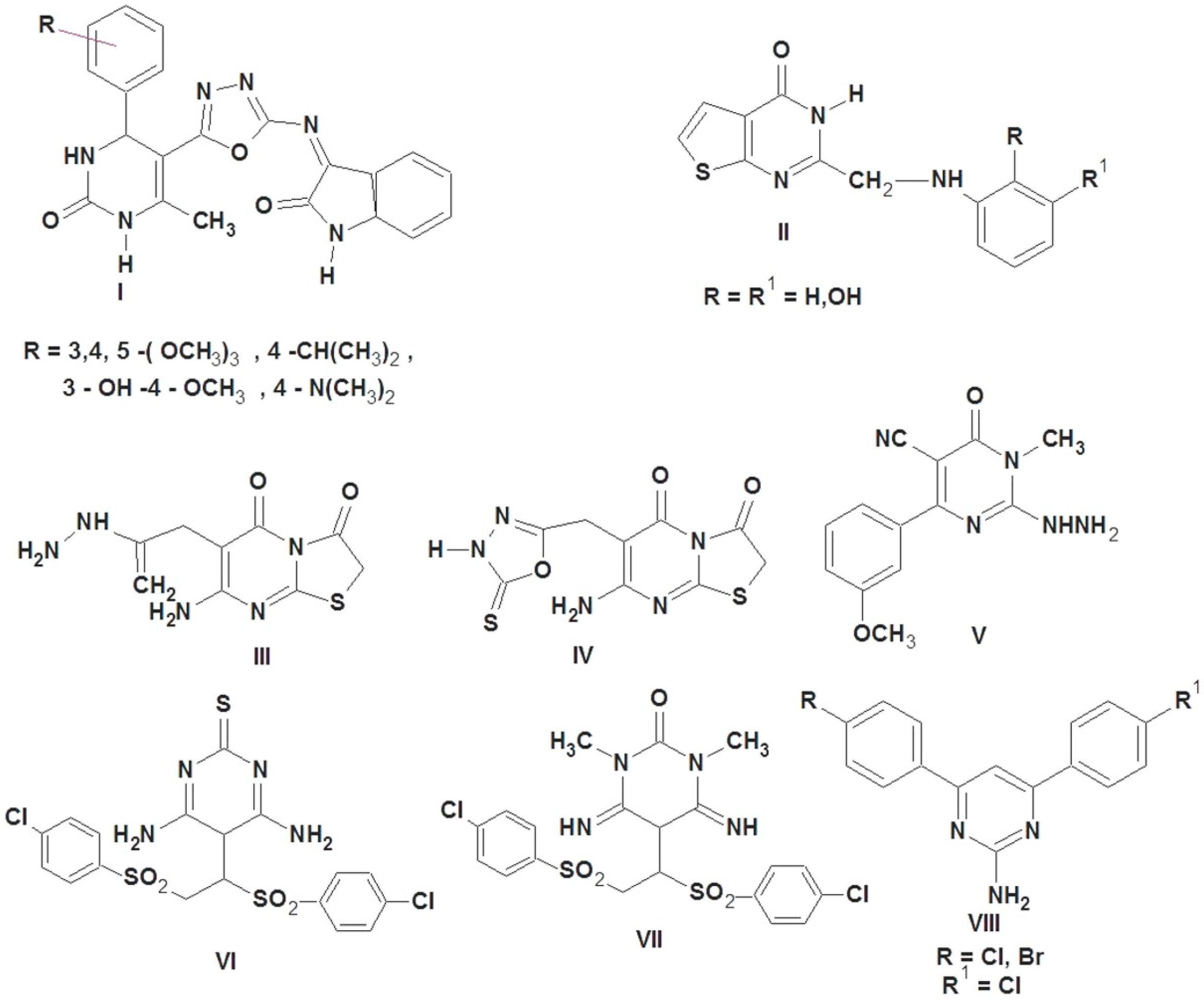
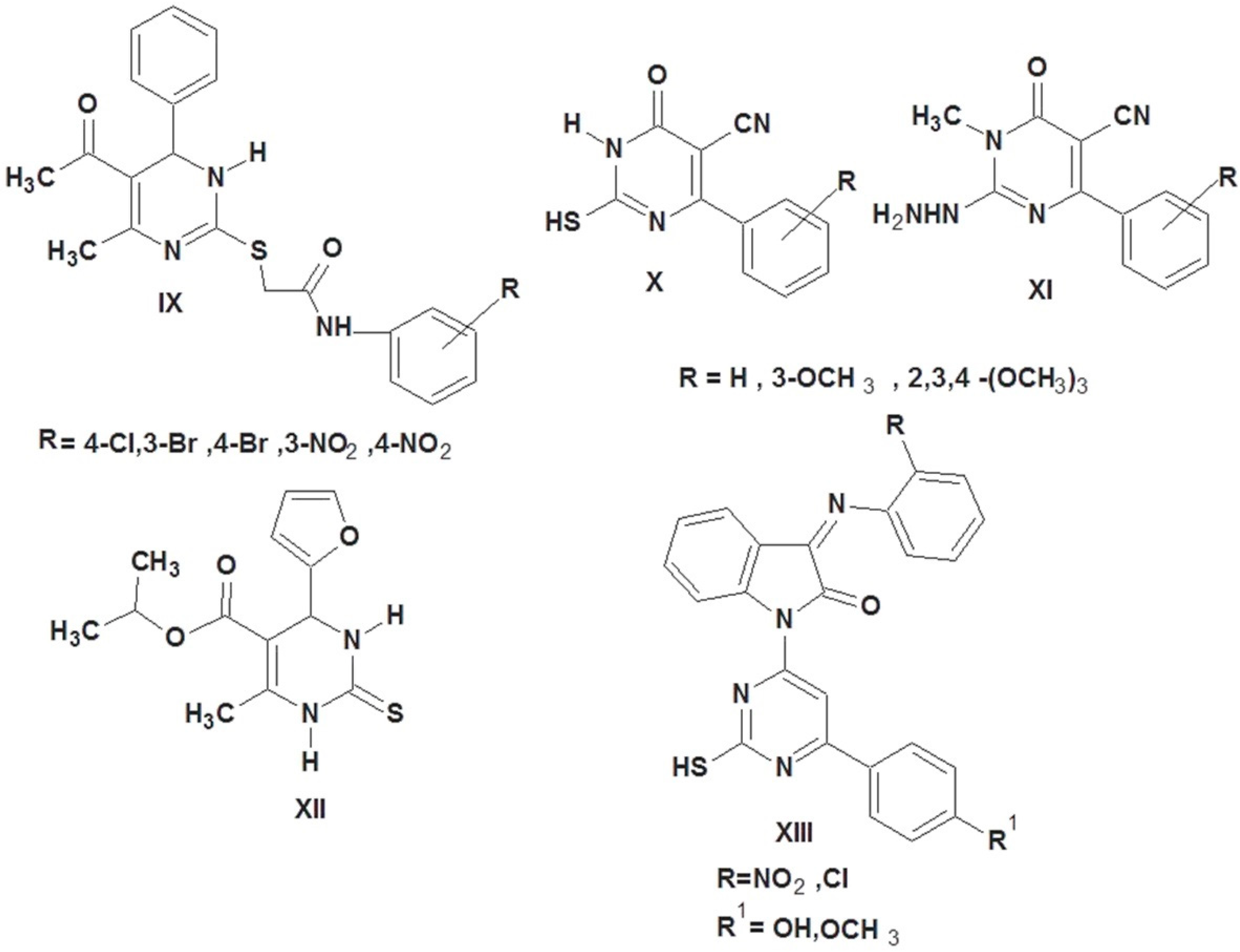

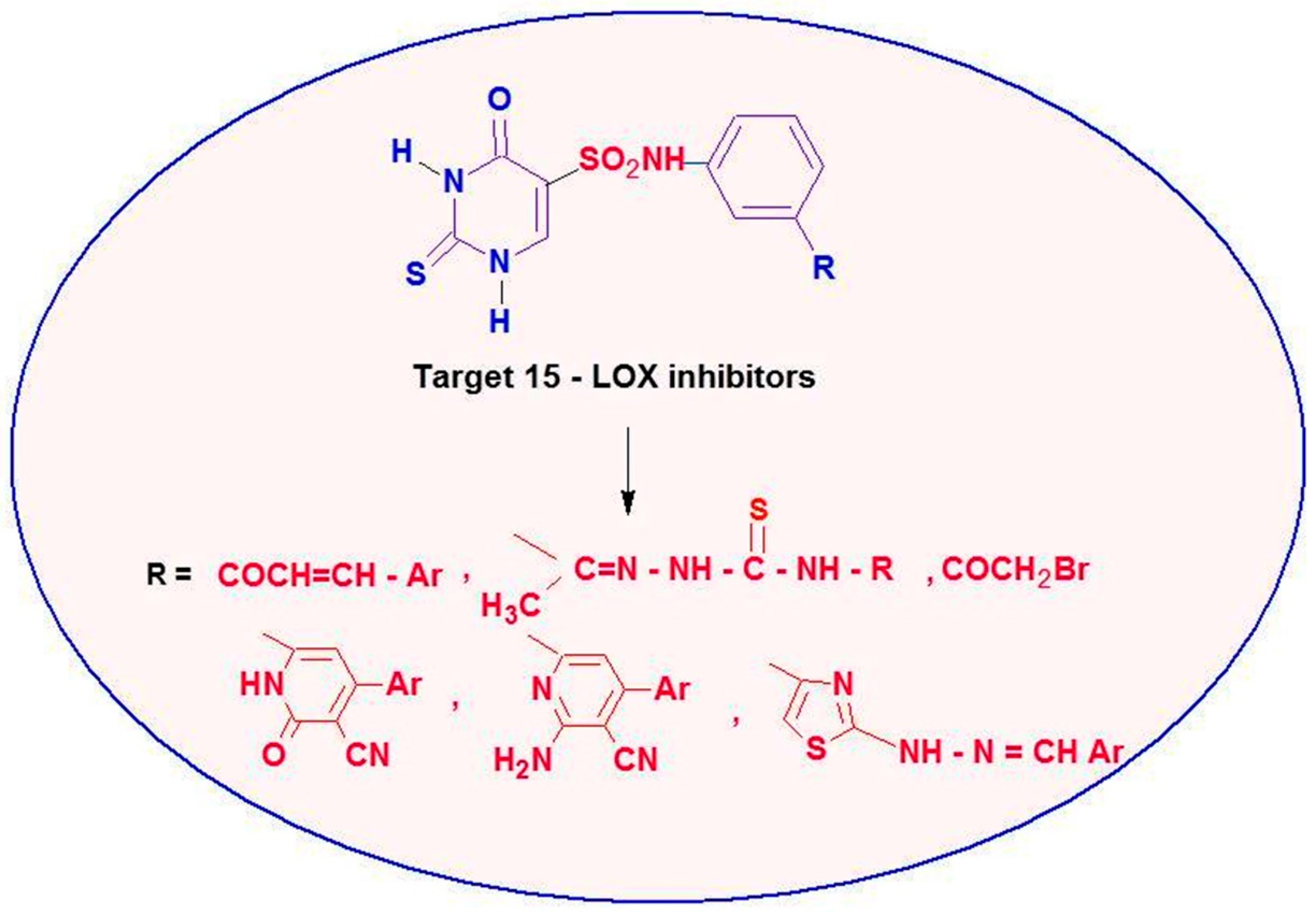
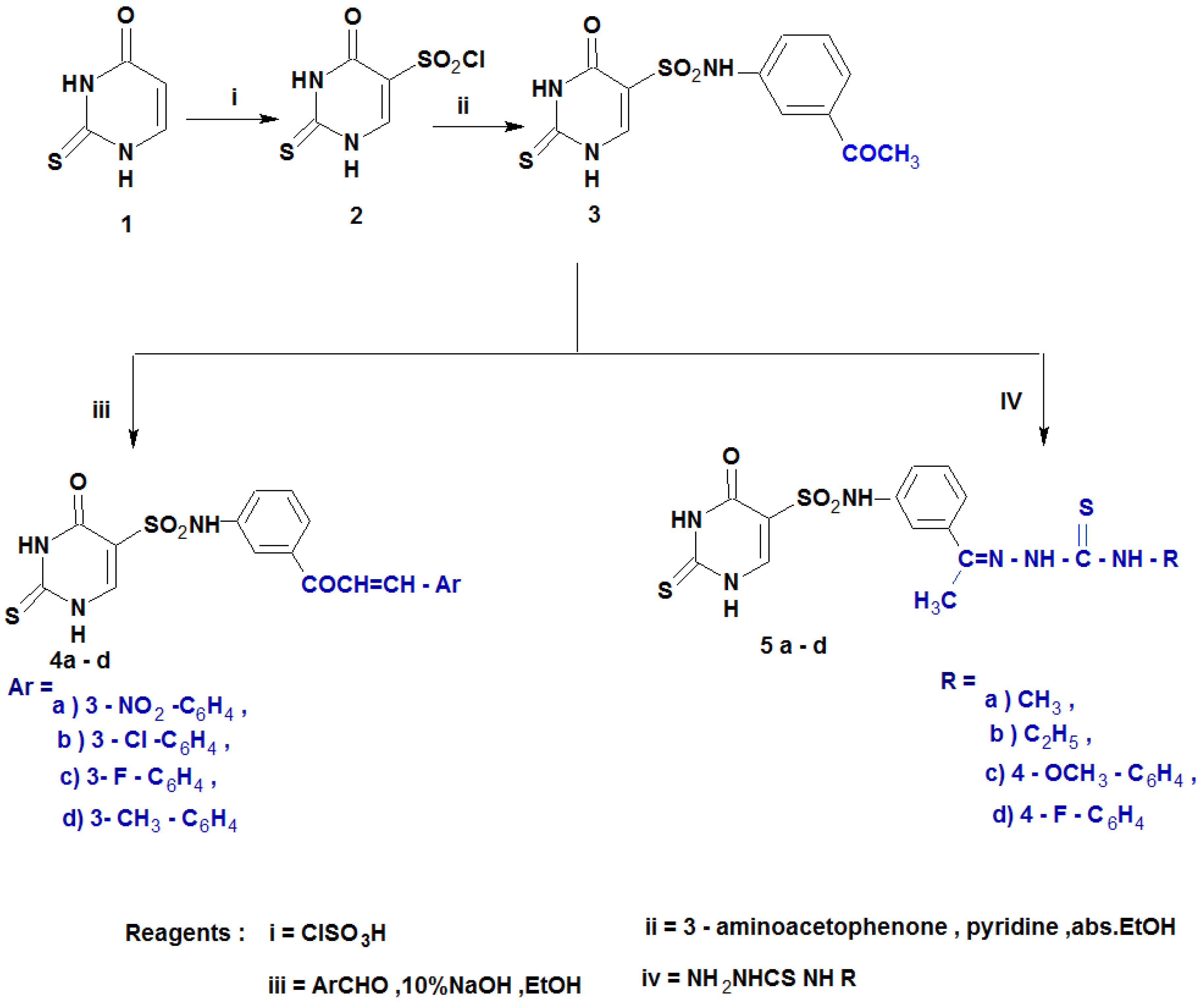
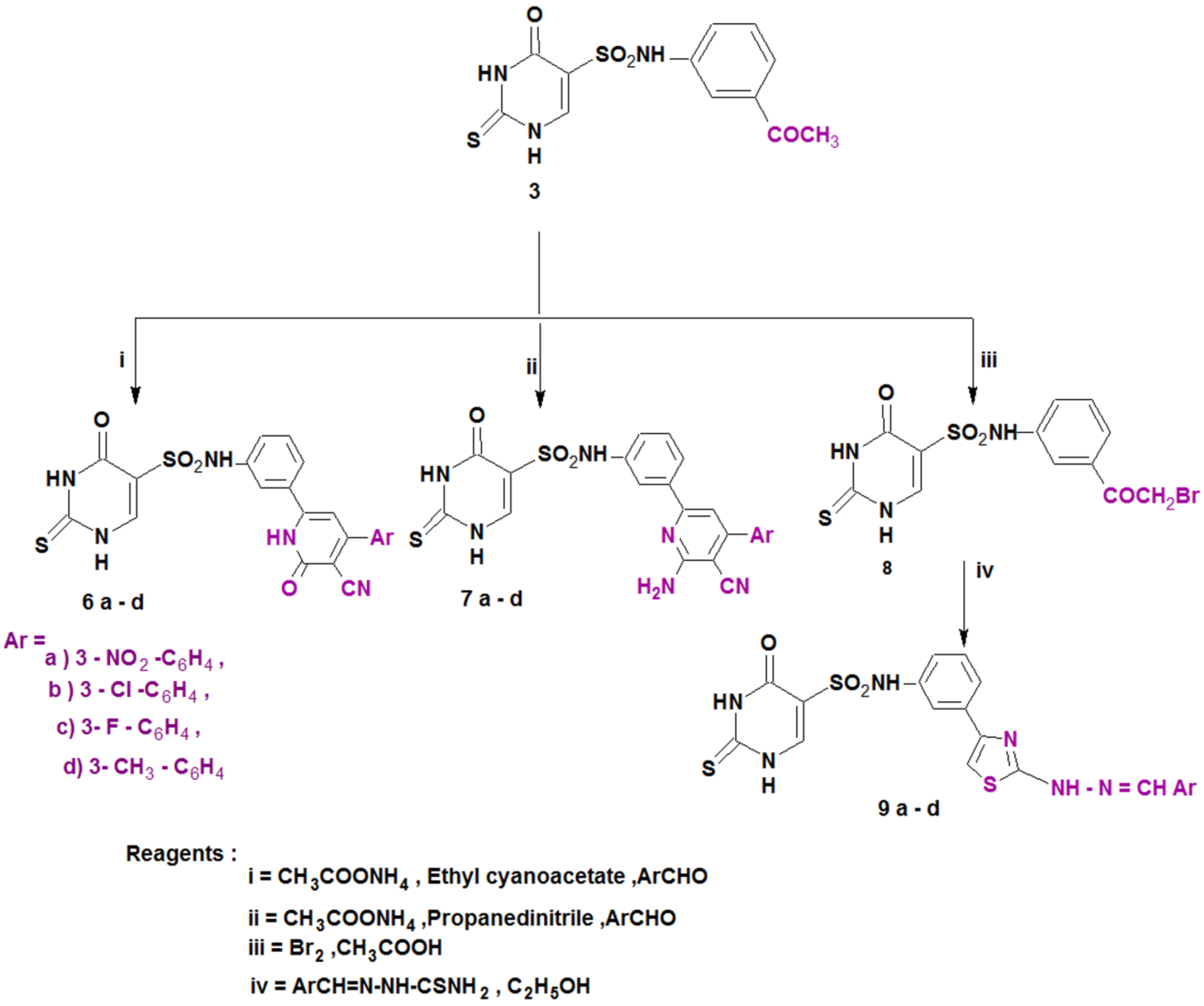

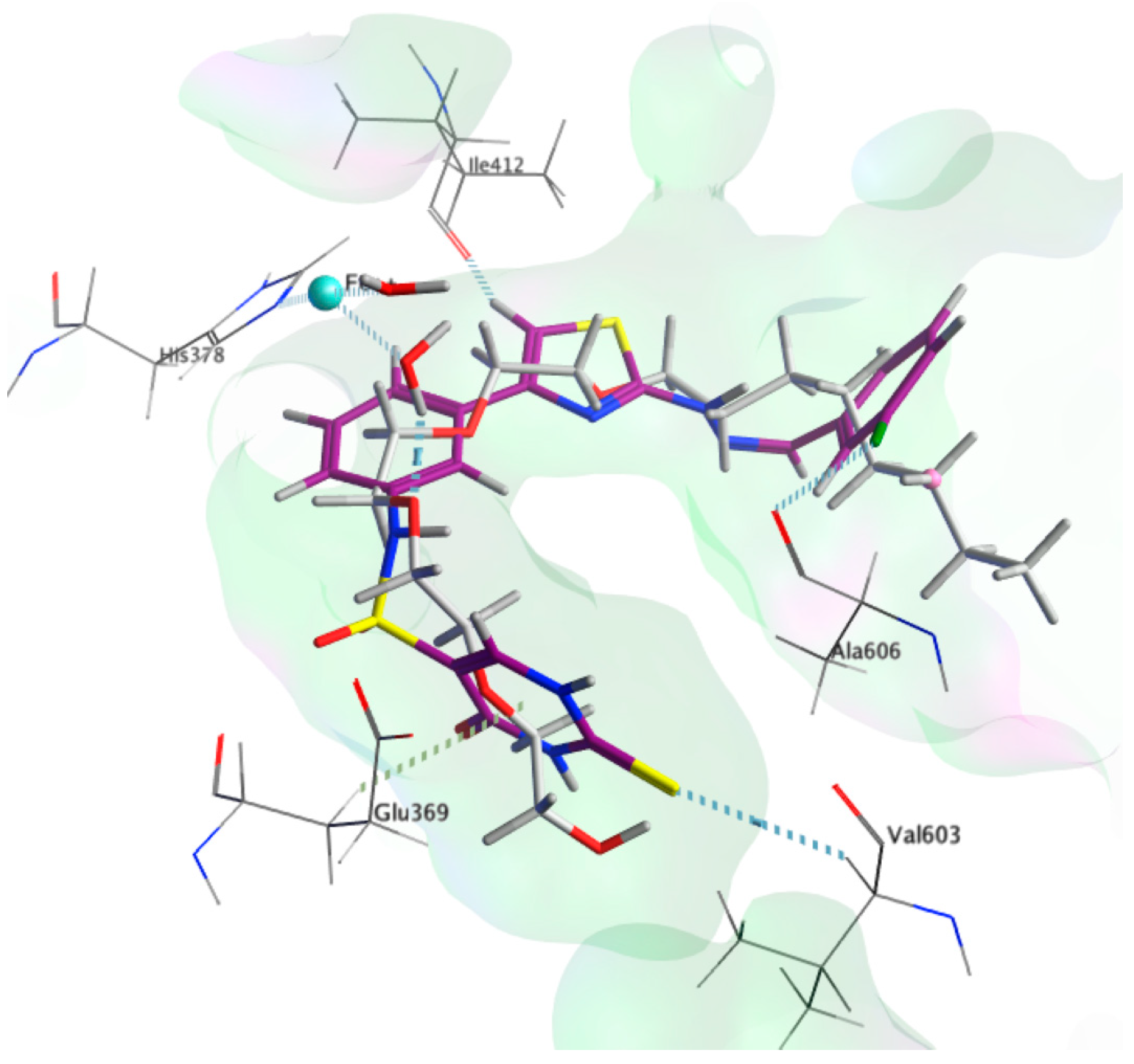
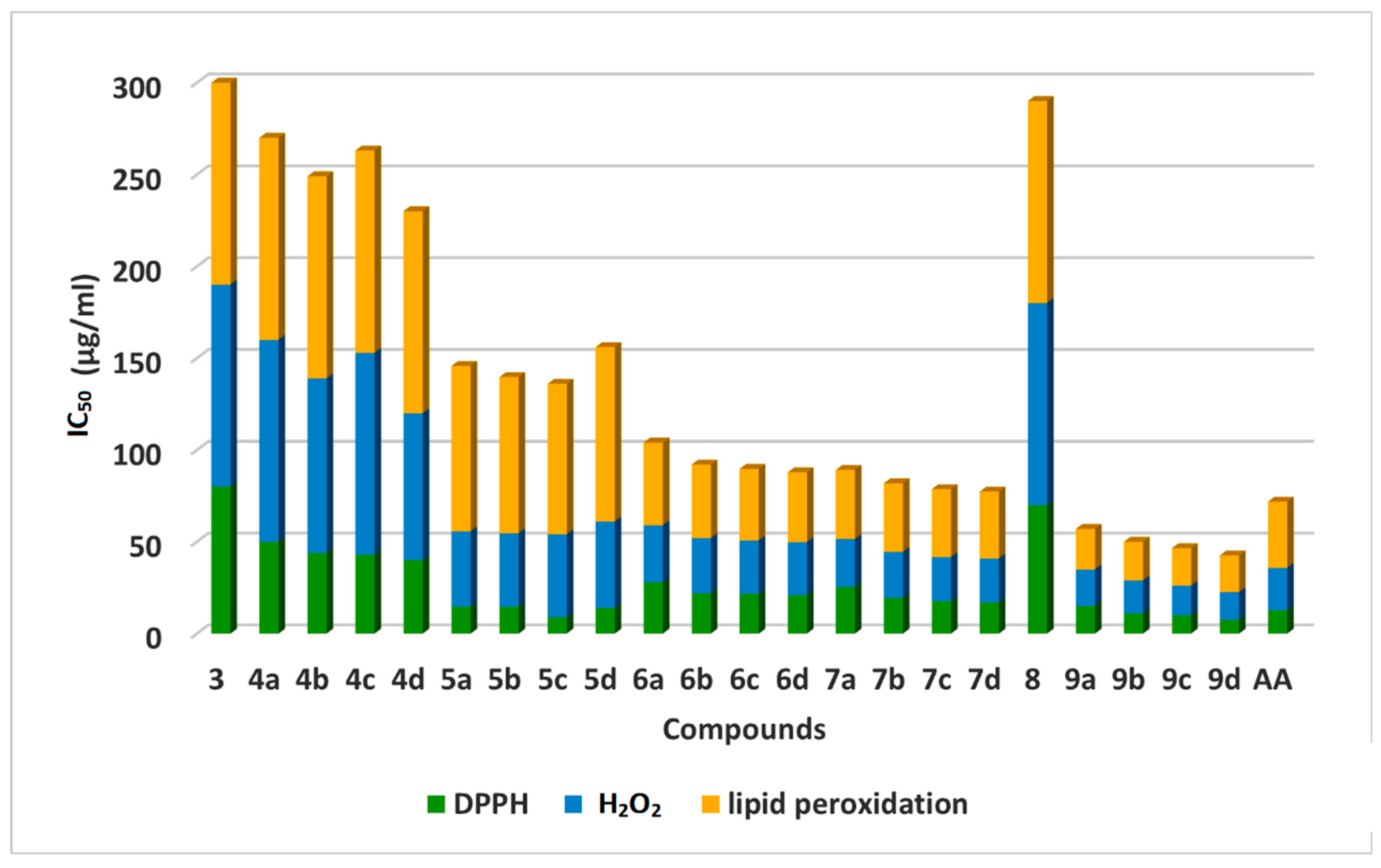
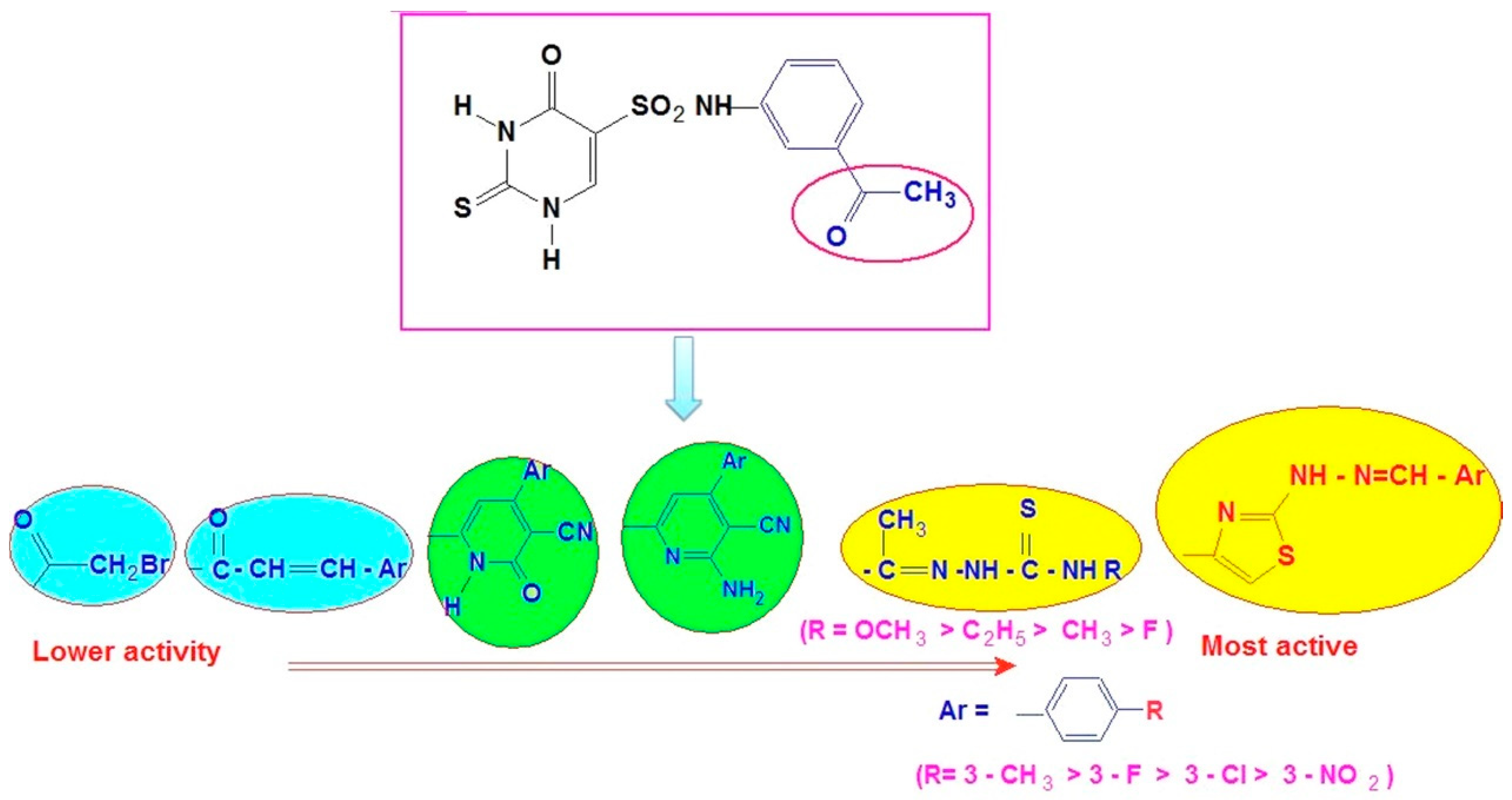
| Compounds | Docking Score |
|---|---|
| Substrate mimic | −10.9 |
| Protocatechuic acid | −5.6 |
| 9b | −9.8 |
| Compounds | DPPH IC50 a (µg/mL) | H2O2 IC50 a (µg/mL) | Lipid Peroxidation IC50 a (µg/mL) |
|---|---|---|---|
| 3 | 80.0 ± 0.70 | >100 | >100 |
| 4a | 50.5 ± 0.79 | >100 | >100 |
| 4b | 44.3 ± 1.67 | 95.0 ± 1.40 | >100 |
| 4c | 43.0 ± 0.50 | >100 | >100 |
| 4d | 40.0 ± 1.70 | 80.0 ± 0.70 | >100 |
| 5a | 14.50 ± 0.72 | 41.0 ± 1.53 | 90.0 ± 1.45 |
| 5b | 14.00 ± 0.22 | 40.0 ± 1.32 | 85.0 ± 1.03 |
| 5c | 9.0 ± 1.10 | 45.05 ± 1.34 | 82.0 ± 1.40 |
| 5d | 14.72 ± 1.11 | 47.0 ± 1.38 | 95.0 ± 1.42 |
| 6a | 28.0 ± 1.06 | 31.0 ± 1.30 | 45.0 ± 1.52 |
| 6b | 22.0 ± 1.18 | 30.0 ± 1.21 | 40.0 ± 1.63 |
| 6c | 21.7 ± 0.7 | 29.0 ± 1.03 | 39.0 ± 1.46 |
| 6d | 21.0 ± 0.5 | 28.8 ± 1.05 | 38.0 ± 1.42 |
| 7a | 25.5 ± 1.16 | 26.0 ± 1.28 | 37.6 ± 1.2 |
| 7b | 19.50 ± 1.06 | 25.0 ± 1.35 | 37.3 ± 1.3 |
| 7c | 17.7 ± 1.4 | 24.0 ± 1.40 | 36.9 ± 1.72 |
| 7d | 17.0 ± 1.63 | 23.9 ± 1.34 | 36.4 ± 1.33 |
| 8 | 70.27 ± 1.17 | >100 | >100 |
| 9a | 15.0 ± 1.25 | 20.0 ± 1.40 | 22.0 ± 1.40 |
| 9b | 11.9 ± 1.40 | 18.0 ± 0.72 | 21.0 ± 1.45 |
| 9c | 10.0 ± 0.83 | 16.0 ± 1.20 | 20.5 ± 1.48 |
| 9d | 7.55 ± 1.70 | 15.0 ± 0.89 | 20.0 ± 1.56 |
| Ascorbic acid | 12.80 ± 0.90 | 23.0 ± 1.37 | 36.0 ± 1.30 |
| Compounds | 15-LOX IC50 a (µM) |
|---|---|
| 3 | ND b |
| 4a | ND |
| 4b | ND |
| 4c | ND |
| 4d | ND |
| 5a | 5.79 ± 0.01 |
| 5b | 5.7 ± 0.03 |
| 5c | 5.5 ± 0.02 |
| 5d | 5.9 ± 0.06 |
| 6a | 7.85 ± 0.01 |
| 6b | 7.6 ± 0.05 |
| 6c | 7.8 ± 0.02 |
| 6d | 7.5 ± 0.04 |
| 7a | 6.95 ± 0.07 |
| 7b | 6.7 ± 0.01 |
| 7c | 6.91 ± 0.02 |
| 7d | 6.6 ± 0.05 |
| 8 | ND |
| 9a | 2.9 ± 0.08 |
| 9b | 1.80± 0.06 |
| 9c | 1.95 ± 0.06 |
| 9d | 2.50 ± 0.03 |
| Quercetin | 3.6 |
Disclaimer/Publisher’s Note: The statements, opinions and data contained in all publications are solely those of the individual author(s) and contributor(s) and not of MDPI and/or the editor(s). MDPI and/or the editor(s) disclaim responsibility for any injury to people or property resulting from any ideas, methods, instructions or products referred to in the content. |
© 2023 by the authors. Licensee MDPI, Basel, Switzerland. This article is an open access article distributed under the terms and conditions of the Creative Commons Attribution (CC BY) license (https://creativecommons.org/licenses/by/4.0/).
Share and Cite
Ahmed, N.M.; Lotfallah, A.H.; Gaballah, M.S.; Awad, S.M.; Soltan, M.K. Novel 2-Thiouracil-5-Sulfonamide Derivatives: Design, Synthesis, Molecular Docking, and Biological Evaluation as Antioxidants with 15-LOX Inhibition. Molecules 2023, 28, 1925. https://doi.org/10.3390/molecules28041925
Ahmed NM, Lotfallah AH, Gaballah MS, Awad SM, Soltan MK. Novel 2-Thiouracil-5-Sulfonamide Derivatives: Design, Synthesis, Molecular Docking, and Biological Evaluation as Antioxidants with 15-LOX Inhibition. Molecules. 2023; 28(4):1925. https://doi.org/10.3390/molecules28041925
Chicago/Turabian StyleAhmed, Naglaa M., Ahmed H. Lotfallah, Mohamed S. Gaballah, Samir M. Awad, and Moustafa K. Soltan. 2023. "Novel 2-Thiouracil-5-Sulfonamide Derivatives: Design, Synthesis, Molecular Docking, and Biological Evaluation as Antioxidants with 15-LOX Inhibition" Molecules 28, no. 4: 1925. https://doi.org/10.3390/molecules28041925
APA StyleAhmed, N. M., Lotfallah, A. H., Gaballah, M. S., Awad, S. M., & Soltan, M. K. (2023). Novel 2-Thiouracil-5-Sulfonamide Derivatives: Design, Synthesis, Molecular Docking, and Biological Evaluation as Antioxidants with 15-LOX Inhibition. Molecules, 28(4), 1925. https://doi.org/10.3390/molecules28041925








